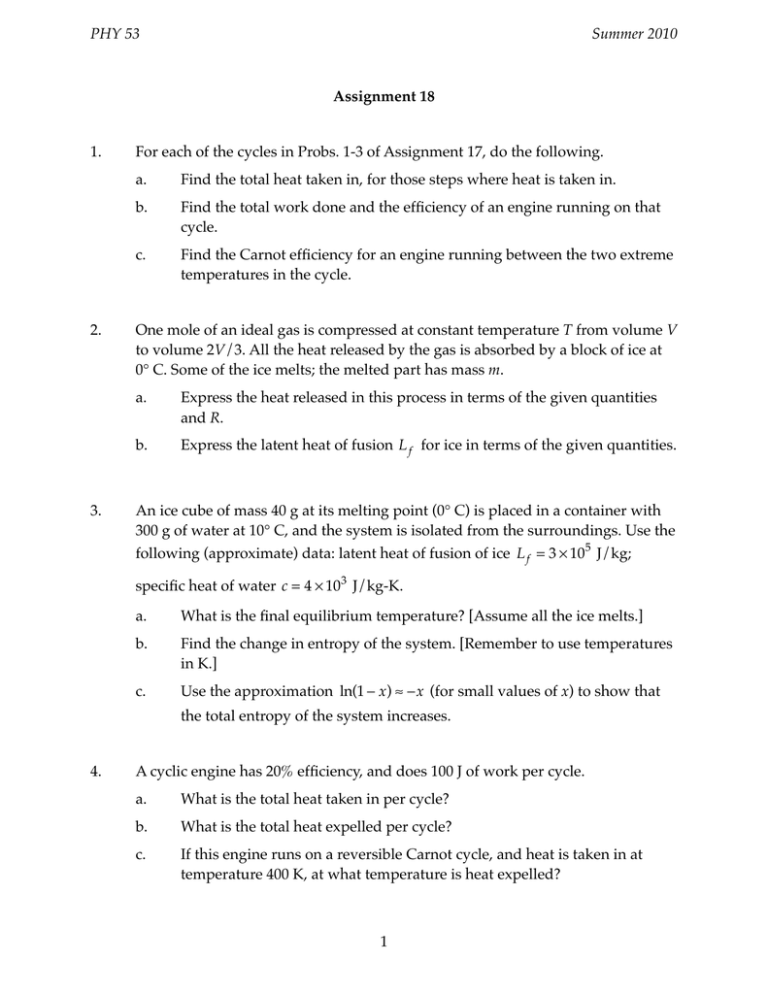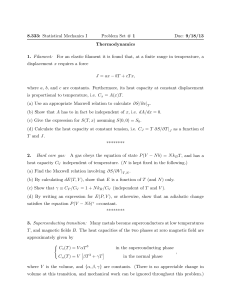Document 11647629
advertisement

PHY 53 Summer 2010 1. For each of the cycles in Probs. 1-3 of Assignment 17, do the following. 2. 3. Assignment 18 a. Find the total heat taken in, for those steps where heat is taken in. b. Find the total work done and the efficiency of an engine running on that cycle. c. Find the Carnot efficiency for an engine running between the two extreme temperatures in the cycle. One mole of an ideal gas is compressed at constant temperature T from volume V to volume 2V/3. All the heat released by the gas is absorbed by a block of ice at 0° C. Some of the ice melts; the melted part has mass m. a. Express the heat released in this process in terms of the given quantities and R. b. Express the latent heat of fusion L f for ice in terms of the given quantities. An ice cube of mass 40 g at its melting point (0° C) is placed in a container with 300 g of water at 10° C, and the system is isolated from the surroundings. Use the following (approximate) data: latent heat of fusion of ice L f = 3 × 105 J/kg; specific heat of water c = 4 × 103 J/kg-K. a. What is the final equilibrium temperature? [Assume all the ice melts.] b. Find the change in entropy of the system. [Remember to use temperatures in K.] c. Use the approximation ln(1 − x) ≈ −x (for small values of x) to show that the total entropy of the system increases. 4. A cyclic engine has 20% efficiency, and does 100 J of work per cycle. a. What is the total heat taken in per cycle? b. What is the total heat expelled per cycle? c. If this engine runs on a reversible Carnot cycle, and heat is taken in at temperature 400 K, at what temperature is heat expelled? 1 PHY 53 5. Summer 2010 A heat pump is a refrigerator for which the hot and cold reservoirs can be interchanged. In summer, when it functions as an air conditioner, it takes heat QC per cycle from the interior of the house at temperature TC and expels heat QH to the outdoors at temperature TH . In winter, it takes heat QC per cycle from outdoors at temperature TC and expels heat QH to the interior at temperature TH . Assume the device runs on a Carnot cycle and consumes energy W per cycle. a. For summer operation, one wants the ratio QC /W to be as large as possible. Express this in terms of the temperatures. Evaluate it for indoor temperature 22° C and outdoor temperature 32° C. b. For winter operation, the corresponding quantity is QH /W . Express this in terms of the temperatures. Evaluate it for indoor temperature 19° C and outdoor temperature 4° C. 6. An air-conditioner is used to maintain temperature TC inside the house, while heat flows into the house by conduction through the walls, windows, etc. Call the area of the exterior of the house A and call its average thermal conductivity to the interior K. The outdoor temperature is TH , and the air-conditioner works on a reversible Carnot cycle, consuming energy at a rate dW /dt . a. To keep the temperature constant, the air-conditioner must take heat out of the house at rate dQC /dt . Express dW /dt in terms of this quantity and the temperatures. b. Express s in terms of K and the temperatures. [What is the net rate of heat flow into the house?] c. Find the rate of increase in total entropy dS/dt , in terms of K and the temperatures. 2








